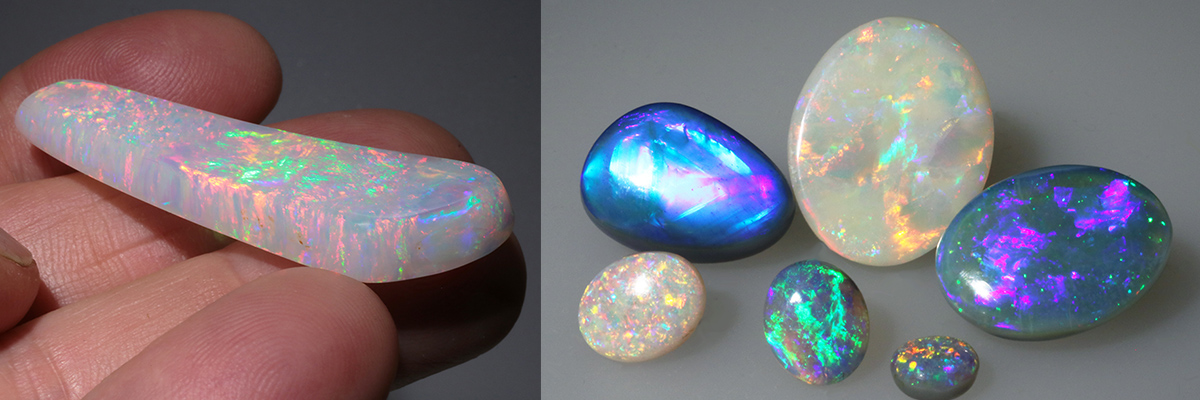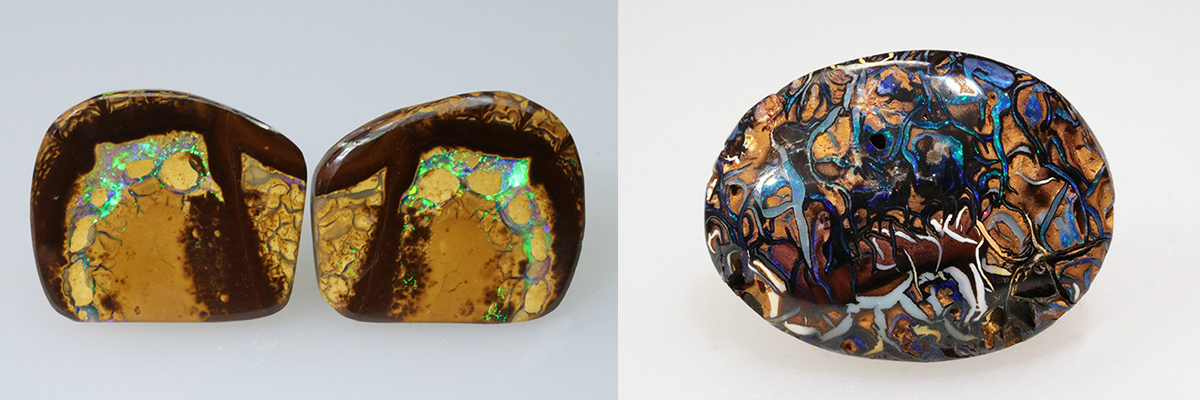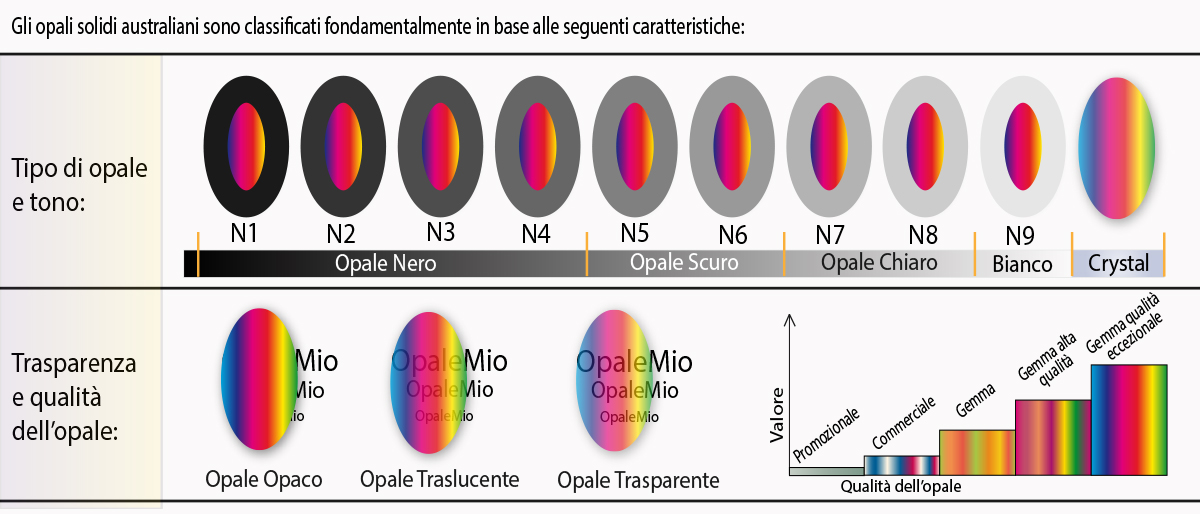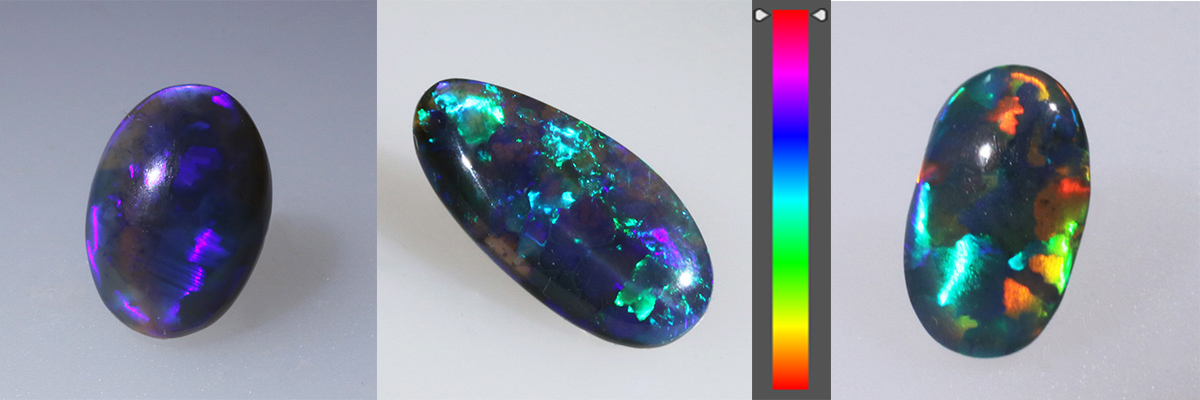Each opal is a unique and unrepeatable gem. Assuming that creating an order to classify this gem (in order to determine the different grades of saturation, the play of colours, the different patterns, as well as brightness, transparency and tone) is not easy, an opal lover might find the analysis and evaluation of an opal quite hard. Over the years different miners have developed a local terminology to describe the different qualities of opal. However, some gemologists don’t believe that this represents a precise classification of the gem characteristics. Sometimes you run into new subjective classifications which may say exactly the opposite of the reality. Even if we follow these guidelines, we find ourselves in an unclear tangle of rules. Over the years, however, a partial catalog of opal gemstones has been developed . opals are classified following certain characteristics:
1. Type of opal
2. Body tone
3. Transparency
4. Play of colors
5. Brightness
6. Patterns
7. Shape
After careful consideration, in order to provide the customers with consistent and clear information, Opalemio decided to take into account only these parameters (commonly accepted by opal experts) avoiding individual interpretations that have produced and still produce confusion. We are confident that this information will help you understand and appreciate the quality of our gemstones.
1. TYPE
Solid opal is found in three different types:
Solid Type 1 - Homogeneous gemstone containing both precious opal and/or common opal (potch).

Solid Type 2 - A layer of precious opal on host- rock which can have different chemical compositions. This type of opal is commonly called Boulder.

Solid Type 3 - fractures and pores of the host-rock filled by precious opal. The rock displays specks and veins of opal which create beautiful designs (e.g. Yowah Nut Koroit). This type of opal is called Matrix.

2. BODY TONE
The body tone of an opal relates to the colour of the background of the opal. In other words, in order to identify the body tone of an opal the observer, rather than focusing on the colours or pattern, will concentrate on the background of the gem. The background of the gem can be white (N9), or black (N1 ) passing through the different shades of grey.
From N1 to N4 - Black opal Category of opal which shows a play of colours on a background that goes from black (the most rare and precious (N1) to dark gray (N4).
From N5 to N6 - Dark opal Kind of opal which shows a play of colours on a dark or gray background. Sometimes this category is also called semi-black.
From N7 to N8 Light opal - N9 White opal Category of opal which shows a play of colors on a light background that changes from pale gray to milky white (N9). The latter is also known as white opal (white opal).

3. TRANSPARENCY
Precious opal can occur in all forms of the diaphanous going from semi-transparent (translucent) to opaque. The range of tones is only available for opaque opals, while crystal opals, which are transparent or translucent,are influenced by the background surface on which they are placed.

4. PLAY OF COLORS
The unique feature in the opal is the presence of different colors in the gem. It ranges from blue to green and yellow to orange and red. The general rule is that the more colors, the greater the value of the stone. Furthermore, the presence of rarer colors, such as red in the Australian opal and blue in the Ethiopian opal, increase their value exponentially. So, for example, for the same tone, carats, brilliance and cut, an opal with a play of only blue colors will be less valuable than an opal with blue and green, which in turn will be less precious than a gem with a play of blue, green and yellow colors, which will be surpassed in quality by a stone with the colors blue, green, yellow and orange. If then there is also red, we are at the top.

5. BRIGHTNESS
The brightness and the vividness of the colors of an opal is a key factor that helps determine the value of an opal. A bright opal, even if small, has a disproportionately greater value than a very large but pale opal. In recent years, there has been some confusion in accepting the common measurement scale. OpaleMio believes in the importance of giving the customers a guideline in the purchase of opals although the indications contained in the guideline are not completely exhaustive. However this is the scale that has been used and currently used to distinguish the brightness of the gemstone. This scale consists of five levels.
B 7 - Very weak - The opal shows hints of color only in sunlight.
B 6 - Weak - The opal shows a weak play of colors both under the sunlight and the artificial light of the lamps.
B 5 - Not very bright - The opal shows a certain play of colors both under the sunlight and the artificial light of the lamps.
B 4 - Bright - The opal shows a beautiful play of colors both under sunlight and artificial light. It does not show any color when shaded away from light.
B 3 - Very bright - The opal shows a nice play of colors under a weak artificial light and a very good one under the sun's rays. If put in the shade you can see the colors.
B 2 - Brilliant - The opal has an intense play of colors both under artificial and solar light and remains very bright when seen in dim light.
B 1 - Exceptionally Brilliant - The opal has a vivid play of colors and electric reflections in any light and is even brighter when seen in the dim light.
Which of these brightness levels does my opal belong to?
Take your opal around noon on a clear day with a beautiful blue sky and bring it in the shade of your home by exposing the opal to the north. At this point you can determine the brightness of your gem by measuring the play of colors that you observe with the five levels of brilliance. Simple, isn't it?
PATTERNS
This English term applied to the opal indicates the ornamental design of its surface, the geometric repetition of a motif. Patterns are a very important aspect in the evaluation and these come in such a variety of nature’s own design, exclusive to opals. Below is a list of the most popular patterns: (taken from the book "To rediscover opals in Australia" by Stephen Aracic):

Harlequin: is surely at the top of the list and the most prized of all brilliant opal patterns. Such rarities portray spangles of rounded, angular to roughly square patches, presenting a harlequin appearance of interchanging colors. They resemble the colorful spangled costume worn by clowns. More
Ribbon: resembling ribbons of changing colors across the stone, which can be in wavy bands or straight thin lines.
Pinfire: seen as pinhead spots, the most outstanding being a color unit, perhaps red, radiating one way, with changes to another colour, perhaps green, when turned at various angles. Some pinfire colors blend into peacock tail design, either on part of those stone or form a central nucleus. Other pinfire colors blend into fern or foliage design.
Stardust: has lovely speckled points of multi-colors.
Flag: colors arranged in three-cornered flagstone design. Some patterns resemble fish scales.
Chinese writing: rare and precious design where the colors form a design similar to the characters of Chinese writing.
Chaff: presents colors in segments like chopped chaff or in multiple situated parallel lines.
Mackarel sunset: presents broken streaks of color spectrum, likened to sunset through the clouds.
Butterfly: has colors arrangement formed like patterns of butterfly wings.
Mossy: a splotchy colored sheen in moss effect. Floral: a flashy effect like a bunch of flowers, seen frequently in Queensland opals.
Rolling flash: brilliant colors rolling across the face of opal, some having a cat’s eye, rolling effect. Green is especially striking rolling across the stone.
Star: has a six-pointed star directional effect floating across the face-off the opal and is very rare.
Rainbow: the colors are positioned like a rainbow.
SHAPE
The shape or type of cut determines the final evaluation of an opal too. For example, a regular and symmetrical shape, such as an oval, drop or cushion shape, is of greater value than an irregular or asymmetrical shape. Furthermore, an opal cabochon, that is oval and thick, is all the more precious the higher its thickness and the regularity of the curvature from the base to the top.

